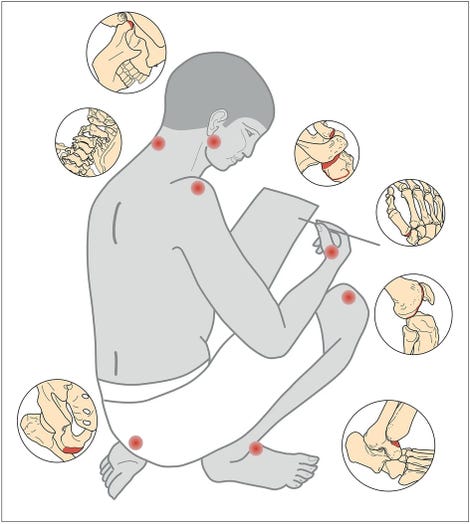Ancient Egyptian scribes held high-status jobs, making up some of the 1% of Egyptians who could read and write at that time. But the scribes suffered for it: New research published in Scientific Reports reveals that the ancient documentarians suffered from osteoarthritis as a consequence of their labors.
The discovery was made by a team of archaeologists who studied the remains of 69 adult males found in the necropolis at Abusir, Egypt, which was used between 2700 BCE and 2180 BCE. The team found statistically significant differences in the skeletal traits of the scribes compared to a reference population; those degenerative changes were concentrated in the joints, spines, and jaws of the scribes.
“Most of these statistically significant differences” in skeletal traits “show a higher prevalence of the observed changes among the scribes (90%), which allows us to deduce that they might be related to scribal activity,” the researchers wrote, though they noted that factors such as age cannot be ruled out as a cause of some of the disfigurements.
“Officials with scribal skills belonged to the elite of the time and formed the backbone of the state administration,” Veronika Dulíková, an Egyptologist at Charles University and co-author of the study, told LiveScience. Fitting, then, that the scribes’ own backs would feel the weight of the kingdom, and carry evidence of it to the grave.

“In a typical scribe’s working position, the head had to be forward, and the spine flexed, changing the centre of gravity of the head and putting stress on the spine,” the research team wrote in the paper. Over time, the load put on the upper spine—in particular the C7-T1 motion segment, the authors note—could cause degenerative effects in the cervical spine of the Ancient Egyptian scribes.
Another disfigurement identified in the skeletal remains was to the temporomandibular joint, familiarly known as TMJ. TMJ disorders are responsible for jaw pain in many people today; in the scribes, the team wrote, it was likely caused by chewing the brush used to write hieroglyphs (in that regard, the scribes’ condition likely differs from most modern TMJ disorders). Other upper body disfigurements included osteoarthritis in the hand, which “probably reflects pinch grip work, such as frequent gripping of the pen,” the team noted. Anyone who took a standardized test with a No. 2 pencil growing up can probably relate.
In the lower body, the researchers found a higher incidence of osteoarthritis in the hip, knee, and ankle, indicating that the scribes may have preferred a specific sitting position “which could also cause overloading of the lumbar spine.” If you haven’t yet, please consider your own posture as you read this article and adjust it accordingly.
